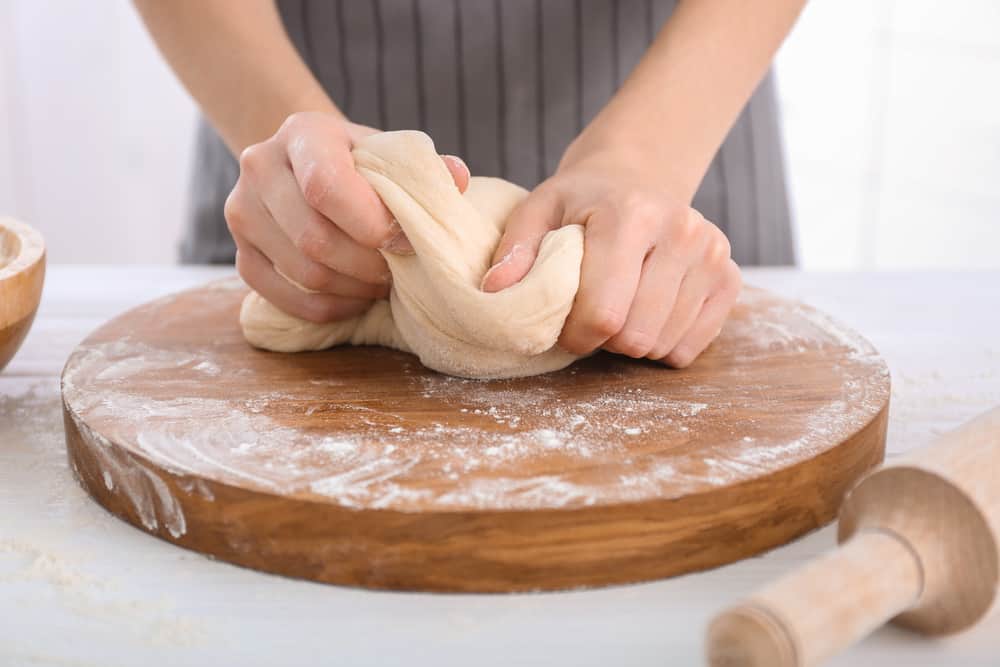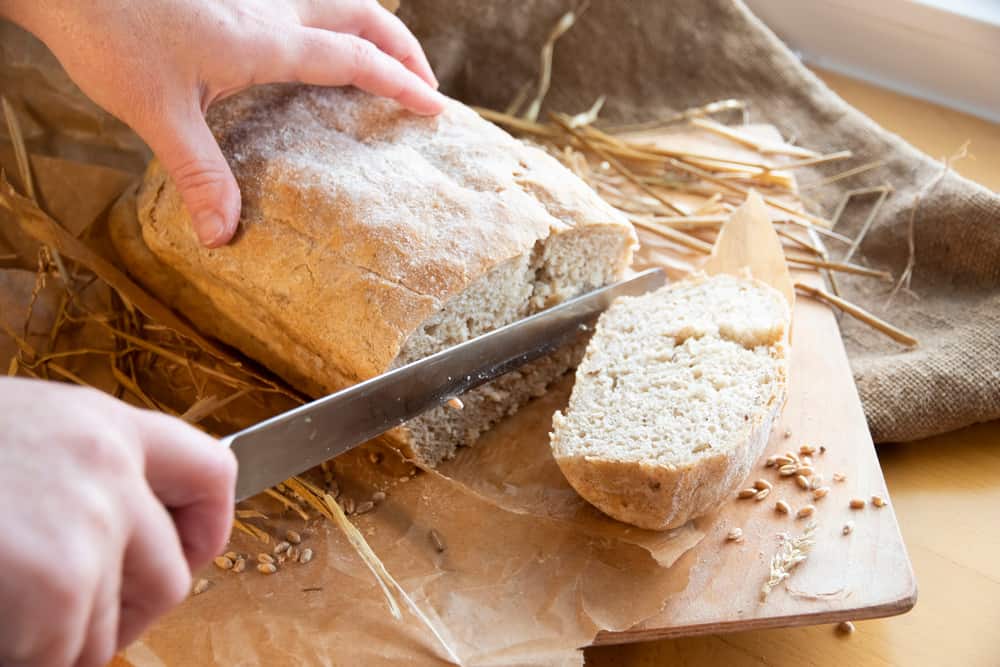Baking
Making your homemade bread became a lockdown trend. The tantalizing smell as a fresh loaf emerges from the oven is carb heaven. But if that first bite is tasteless, the disappointment is thick as butter. How to fix it?
Homemade bread is often tasteless due to over-kneading, bread is fermenting too fast, or the yeast is old. The problem is rarely due to not enough salt.
The tricky part is knowing which error is preventing your bland brick from being a delicious sensation. In this article, we will help look at the possible reasons your bread may not be reaching your taste expectations. We will discuss ways to add flavor to your loaves in fun and healthy ways.
You are over-kneading dough
Over-kneading dough is practically impossible for old-school bread makers that knead by hand. Even healthy and fit individuals will become too tired before their dough becomes overworked. But in the age of dough hooks and mixers, this problem has become common. The gluten in the dough becomes damaged and loses its elasticity. Over-kneading results in bread loaves that have tough crusts with dry and crumbly interiors. It will be difficult to slice.
Signs your dough is over-kneaded
- Dough is too dense to fold or flatten.
- Dough feels stiff.
- Dough easily tears when stretched.
If you are using a mixer, stop every two minutes and check your dough. If it doesn’t hold its shape, is sticky, or has what is known as a “shaggy look” your dough needs more kneading. (Don’t add more flour. This can make your loaf crumbly.) Ideally, you want a smooth ball that springs back when poked, and you can stretch a small piece without it tearing or breaking.
If you have over-kneaded your dough, you can try to leave it to rise for longer. This won’t fix everything but might help salvage the loaf.
Your bread is fermenting too fast
Bread gains the bulk of its flavor through the fermentation process, also known as “proofing”. This is especially true for breads that use a starter, such as sourdough. If your bread rises too quickly, it can destroy the flavor of leaving behind an alcohol aftertaste. The resulting loaf will be dry with lots of holes.
Reasons for fast fermentation:
- You went overboard with the yeast.
- That water added to the yeast exceeds 120F.
- Your dough was set to rise in an area that is too warm, either because of your climate or you set it in an oven.
To fix these issues:
- Use the correct amount of yeast.
- Use water that is below 120F in your recipe.
- Set your dough in a cool place in the home or put it in the fridge overnight.
Your yeast is too old
Yeast doesn’t last forever. Improper storage can shorten its life span. Remember to store yeast in a dry and cool place. If you live in a warm or humid climate, you might want to keep your sealed yeast in the fridge. The fridge is also best for an open pack of yeast. Please note, if you do keep yeast in the fridge, remove it before use (30-40 minutes) to ensure it reaches room temperature.
So how do you know if your yeast is still good?
Test your yeast in four simple steps:
- Step 1: Mix ½ cup of warm water with a teaspoon of granulated sugar. Stir the mixture until sugar has dissolved.
- Step 2: Add 2 ¼ teaspoons of yeast to the sugar water and stir.
- Step 3: Wait 10 minutes.
- Step 4: Check the mixture. If the mixture has now risen, full of bubbles and giving off a yeasty scent, then your yeast is still good. If the water is flat and there is no rise, your yeast is bad.

Other tips for adding extra flavor to homemade bread
Even with all these tips, you might want some extra zing to your bread. Here are some other tips that might lift your loaves.
Fresh herbs
Fresh herbs can be a winner in homemade bread. Popular savory additions to dough are oregano, sage, rosemary, thyme, or even try some garlic chives.
Only have dried herbs? That’s fine, but keep in mind that you will need to reduce the amount by about 2/3rds, as dried herbs have a stronger taste than fresh.
Spices
Coriander and ginger can be a great addition to sweeter breads, especially when combined with cinnamon or nutmeg. Remember, like herbs, you need to adjust your quantities depending on if you are using fresh and dried.
Other additions from your spice cabinet you could try: cardamom, saffron, anise, all-spice, and cumin. Raid the fruit bowl and grab an orange or lemon. The rind from these fruits will add a touch of tang.
Seeds and nuts
Seeds and nuts can add both flavor and extra nutrition to your baking. Popular choices are pecans, chai seeds, walnuts, poppy seeds, sesame seeds, flaxseeds, and pumpkin seeds. For a more savory addition, caraway can make a good choice, too. Most seeds and nuts will not require any soaking before adding them. However, toasting them for a few minutes can bring out extra flavor.
Always check that nothing has gone rancid before adding them to your recipe. Too many can also weaken the dough, so add them gradually.
Whole grains
Like seeds and nuts, whole grains can add taste to your homemade bread. However, unlike seeds and nuts, most of these will require between four to 48 hours of soaking before use. Whole grains to try are oats, bulgur wheat, polenta, and cracked wheat, and barley.
Sweeteners
Many recipes call for plan old sugar. Consider trying honey that’s been kept at room temperature for both extra moisture and taste. Malt is also a great alternative, so long as it is nondiastatic as diastatic malt will create sticky dough due to the enzymes.
Fats
Adding oils and fats to bread can bring out delicious flavors. Popular choices olive oil, vegetable, and good old unsalted butter. Adding shortening will give your loaves a lighter, chewier texture, and save on the time required for kneading. Or be truly daring and pair some rosemary with walnut oil.
Do be aware, however, that these ingredients will create some changes to the bread’s texture. Also, if you use a reduced-fat oil or spread, you may need to alter the amount of water in your recipe.
Dry milk powder
Dry milk powder can add a twist on a favorite bread recipe. It can also be a cheaper alternative to fresh milk if you are on a budget. The addition of dry milk also softens a bread’s texture.
For those that avoid dairy, try substituting powder made from coconut, cashew, soy, or rice. However, do check the ratios for these substitutions before adding.
Onion soup mix
If you are pairing your loaf with a hearty soup or stew, consider adding an onion soup mix to your bread recipe by mixing it with the water for your yeast.
Conclusion
Homemade bread can be a nutritious, affordable, and tasty addition to your diet. However, it can be frustrating when the loaf lacks flavor and doesn’t meet your expectations. Baking bread requires time and practice. Be patient, have fun, and embrace new ideas and techniques, such as the ones we’ve suggested. We hope this article both helps you with your troubleshooting and provided some new ways to give your homemade bread a flavorful boost.
